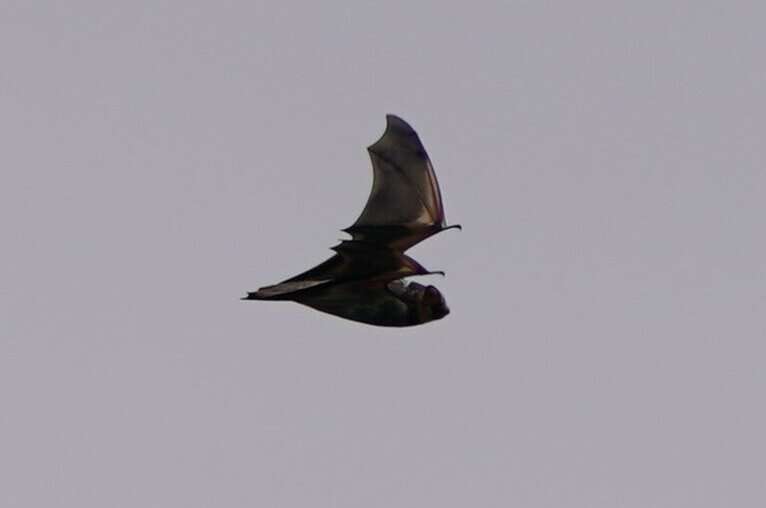This article has been reviewed according to Science X's editorial process and policies. Editors have highlighted the following attributes while ensuring the content's credibility:
fact-checked
trusted source
proofread
Researchers are first to see at-risk bat flying over open ocean

On a research cruise focused on marine mammals and seabirds, Oregon State University scientists earned an unexpected bonus: The first-ever documented sighting of a hoary bat flying over the open ocean.
The bat was seen in the Humboldt Wind Energy Area about 30 miles off the northern California coast; the Humboldt area has been leased for potential offshore energy development, and the hoary bat is the species of bat most frequently found dead at wind power facilities on land.
OSU faculty research assistant Will Kennerley, the first to see the bat, and colleagues documented the sighting with a paper in the Journal of North American Bat Research. The bat was spotted just after 1 p.m. on Oct. 3, 2022, in observing conditions rated as excellent.
"I have spent a lot of time at sea in all oceans of the world, and I've seen a lot of amazing things," said Lisa Ballance, director of OSU's Marine Mammal Institute. "A hoary bat was a first for all of us. It's a reminder of the wonder of nature, and of its vulnerability."
Hoary bats are strong fliers and highly migratory, moving from breeding areas across North America to southern or coastal wintering areas, the scientists said. They are regular visitors to the Farallon Islands near San Francisco and to Bermuda, but a review of current and historic records of offshore bats in North America indicated that a hoary bat had never been spotted from a ship.
Hoary bats can fly as high as 2,400 meters—well beyond the vision of human observers and outside the acoustic range of ultrasonic detectors, which could partly explain why the species has seldom been detected offshore, the researchers note.
Kennerley and Oregon State marine ecologist Leigh Torres were aboard the R/V Pacific Storm as part of the MOSAIC Project, which studies the distributions and densities of seabirds and marine mammals around potential offshore wind energy areas. Ballance is the four-year project's principal investigator.
The bat appeared during a seabird survey 49 kilometers off the coast of Arcata, California. It was flying between 5 and 10 meters above the ocean, generally approaching the Pacific Storm from the north, and got as close as 50 meters to the vessel.
"We, of course, didn't set out to look for bats at sea, but this demonstrates the value of having observers out on the water ready and able to document unexpected observations like this," said Kennerley, who photographed the bat. "I think surprises like this are one of the most exciting parts of doing science."
Research including a 2019 study led by OSU-Cascades suggests the hoary bat, known scientifically as Lasiurus cinereus, is declining at a rate that threatens its long-term future in the Pacific Northwest.
Bat population declines are problematic for a host of reasons, researchers say. In many environments worldwide, bats provide ecosystem services, including pollination, pest control, and seed dispersion. They are one of the most diverse groups of mammals but are not well understood, and have in recent years become at great risk both from wind energy production and from the invasive bat disease white-nose syndrome.
Wind power affects bats through collision and barotrauma, which refers to injuries caused by rapid changes in atmospheric pressure, like what can occur around the blades of a wind turbine. Examination of dead bats collected near turbines often reveals signs of internal hemorrhaging associated with barotrauma rather than collision.
The scientists on the Pacific Storm say their observation provides further evidence that the hoary bats sometimes use offshore habitats. That the sighting occurred within a leased offshore wind energy area highlights the potential for hoary bats to be affected by offshore energy development, they note.
"Our study only documents a single individual but nonetheless suggests a greater need for studies looking at threats bats may face at sea," Kennerley said.
More information: Will Kennerley et al, First Visual Record of a Hoary Bat (Lasiurus cinereus) over the Open Ocean, Journal of North American Bat Research (2024).
Provided by Oregon State University





















